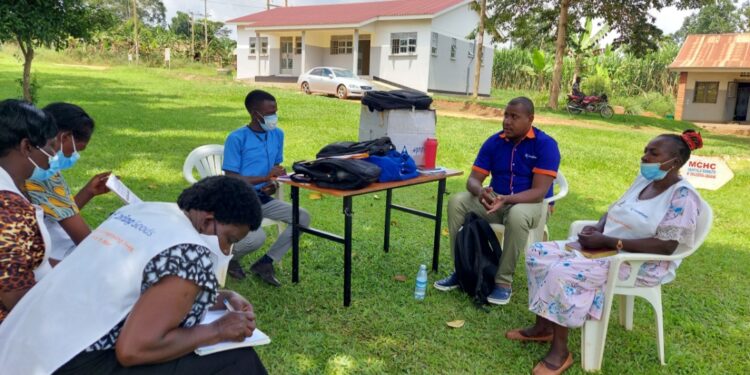Uganda’s Health sector, like that of many developing countries, is faced with challenges ranging from limited resources to accessibility. However, the integration of Information Systems Management offers a promising avenue through which those hurdles can be overcome leading to improve delivery of healthcare services. Though their obstacles that certainly need to be addressed for successful implementation to be realized, ISM has been piloted in Mayuge district in Busoga region and its transformative potential is evident in Mayuge District.
There is improved Patient Care and Efficiency through implementation of Electronic Health Records and the HMIS. EHRs streamline patient information management, ensuring healthcare providers have quick and secure access to comprehensive patient histories and treatment plans. This not only reduces medical errors but also enhances the continuity of care patients by follow ups and monitoring to check on their status. for example, Antenatal care(ANC)and Postnatal(PNC) mothers can receive reminder massages(SMS) on when the next visit is. hence improving immunization and ANC, this has been witnessed in the areas of kityerera and bwondha where living goods has deployed trained vhts in the use of smart phones.
The HMIS helps in the reporting of all Epidemic and Pandemic across the country in a timely manner for example in 2016 a cholera outbreak in bwondha was reported through the HMIS 033b. With this system reports are gotten from Health Centre I by the VHT, Health Centre II, Health Centre III, health Centre IV and Hospital Level. These reports help in decision making and allocation of resources to hospitals like Buluba Hospital, Mayuge Health Centre IV, Buyugu health centre, III, Bukatube Health Centre III, Kityerera Health Centre IV, Buwaya Health Centre II, Kigandalo Health Centre IV, Malongo Health Centre III, Jaguzi Health Centre III, masolya health centre III, busaala health centre III and buwaiswa health centre III bwondha health centre II among others.
Improved Public Health Surveillance and Response ISM facilitates real-time monitoring of disease outbreaks and epidemiological trends through robust Health Management Information Systems through forms like Weekly reports HMIS 033B, monthly reports HMIS I05, HMIS 108, HMIS 009, Quarterly reports HMIS 106a, Annual reports HMIS 107, addendums among others.
By leveraging data analytics and predictive modeling, health authorities can promptly detect and respond to health threats, thereby mitigating the spread of diseases and minimizing their impact on communities. This proactive approach is crucial for maintaining public health and ensuring timely interventions ie during my internship in Busoga region, Mayuge District Malaria, Dysentery and Bilharzia were detected and reported through the HMIS tool at Bwonda Health Centre II and kigandalo health centre IV since the community(population) is on the shores of Lake Victoria. During the COVID19 pandemic at the point of entry, all passengers that passed through bwondha landing site were screened and the first case of covid 19 in the district was got and reported directly to MOH using HMIS. All Health units must report this information (Government, private Health providers and PNFP) to the DHO. Such reports are clearly labeled to show the period covered ie date, month and year
Efficient Resource Management, it enables efficient management of healthcare resources mainly the National medical store(NMS) in the distribution of medicines to government Health facilities, including pharmaceuticals, medical supplies, and human resources. Automated inventory systems and supply chain management tools help healthcare facilities in Uganda optimize stock levels, reduce wastage, and ensure essential medicines are consistently available to patients and Health facilities. This was evidenced in Mayuge Kigandalo health centre IV and Buwaiswa health Centre III where the in charge, inventory officers make orders and requisitions to NMS, medical records assistant (MRA) makes a weekly surveillance report in the HMIS to the District Biostatician and District Health Officer.
It also facilitates community engagement through digital health education initiatives and interactive platforms that promote preventive care practices and encourage active participation in healthcare decision-making. Living Goods Uganda has taken over this model of Digital Health (tele health and tele medicine) and it has greatly improved people’s lives mainly in rural areas or semi Urban places. Village Health Teams (VHTs) are trained to use technology while assessing the patients.
Problems to Effective Information System Management Implementation
Despite its potential benefits, the successful implementation of ISM in Uganda’s healthcare sector faces several challenges:
Infrastructure Limitations, Inadequate internet connectivity and unreliable electricity supply in rural areas pose significant barriers to the seamless operation of ISM solutions. Areas in Mayuge like Jaguzi Islands, Lolwe Island, Malongo, Busakira (busaala) and Bwonda had challenges in Network making it hard for internet connections plus the high costs of acquiring the necessary gadgets for use. This greatly affects the flow of information on online research.
Capacity Building Needs, the shortage of trained IT professionals and healthcare workers proficient in using ISM tools necessitates comprehensive capacity-building initiatives since most of the Health workers have less knowledge of computer usage and Electrical Medical records, HMIS. Government should emphasize the study of ICT to all Medical Health workers in the country this will help to bridge the gap.
In conclusion, while Information Systems Management holds immense promise for revolutionizing Uganda’s healthcare.
Do you have a story in your community or an opinion to share with us: Email us at editorial@watchdoguganda.com













